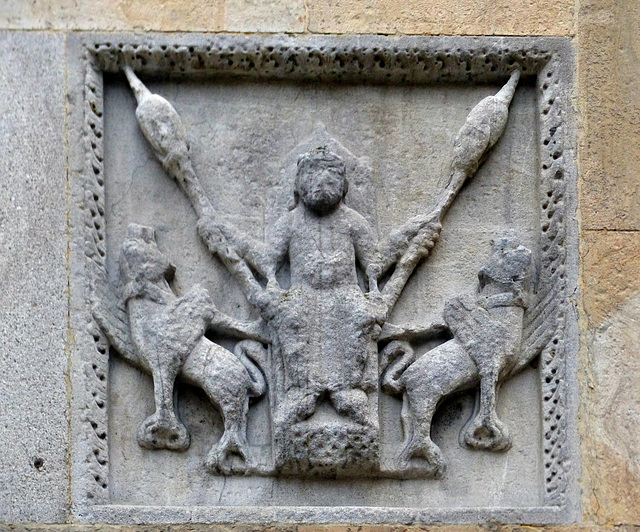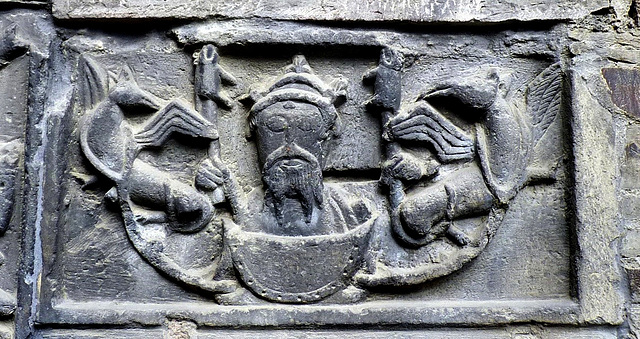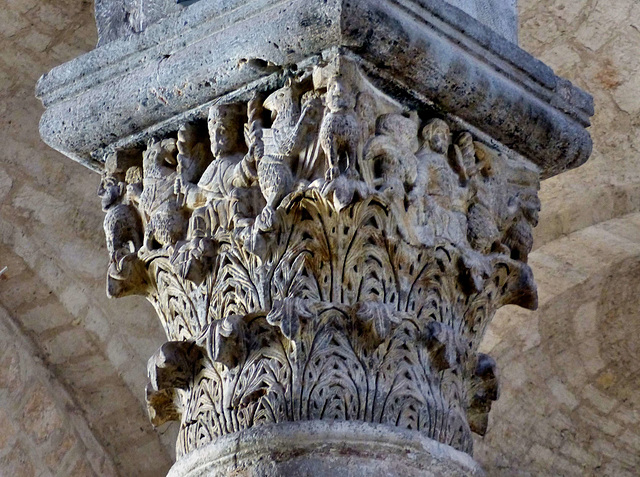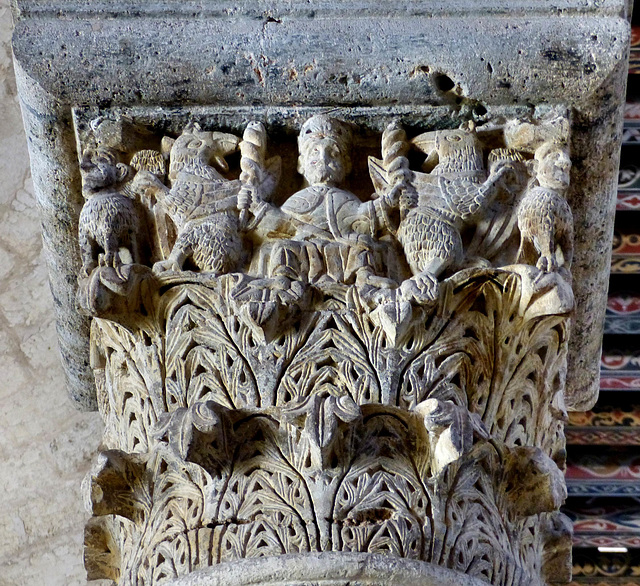
Air Alexander
A legend in the "Alexander romance" has Alexander the Great, wishing to see the whole world from above. To do this he harnessed two large birds or griffins with a seat for him between them. To entice them to keep flying higher he placed meat (some say "roasted puppies") on two skewers which he held above their heads. This was depicted in several medieval cultures.
Fidenza - Cattedrale di San Donnino
In 1927, what is pretty recent, the city "Borgo San Donnino" changed it´s name to "Fidenza", as in Roman times it was known as "Fidentia Julia".
The city was named and the Duomo inside the walls was dedicated to San Donnino di Fidenza (aka "Domninus of Fidenza"), who was martyred nearby in 291.
Sigeric the Serious, Archbishop of Canterbury, made the pilgrimage to Rome following the Via Francigena around 990. His contemporary records of this journey still exist (and are source for the modern guide books). He reached "Sce Domnine" after 36 days, what is pretty fast for more than 1000kms.
The erection of the Cattedrale di San Donnino started in the 11th century, the first consecration took place in 1106, though the building process continued. From around 1200 on Master Benedetto Antelami and his workshop worked here, not only as Master masons. Antelami may as well be the architect of the facade.
Frederick Barbarossa had entrusted "Borgo San Donnino" to the Pallavicino family of Piacenza. In 1268 - after a siege - the city was conquered by the troops of Parma, who looted and burnt down it completely. All houses got destroyed at that time just the Duomo was saved, but it was not completed at that time. The building process came to a stop - and was never continued.
Here is Alexander the Great going up to heaven in a basket, powered by two griffins. Alexander controls the griffins by holding up two roasted puppies on sticks.
Julianna Lees has published a very interesting article, titled "Representations of the Fantastical Adventures of Alexander the Great in Romanesque and pre-Romanesque Art" on her website:
www.green-man-of-cercles.org/articles/alexander.pdf
Remagen - Pfarrhoftor
One of the first printed records about this gate stated in 1859 "Of all old monuments in the Rhine valley, none as mysterious as the portal (...) near the church in Remagen".
The Pfarrhoftor (= Gateway to the parish close) still is enigmatic. It may have been erected for a nearby monastery, that centered around an St. Apollinaris shrine, it may have been in deed a gate to a parish close. Actually it known since the 17th century, when parts of it were found, walled in between the rectory and the encircling wall. The parts were recovered and like pieces of a puzzle joined together.
Though the cope stone was lost, the large arch was easy to reconstruct. Wether the smaller side portal originally was left or right is unclear.
The 22 carved reliefs here have triggered more than a dozend different theories. I will quote some. The carving style was not appreciated by the art-historians. Already Wilhelm Bode ("Geschichte der Deutschen Plastik") wrote in 1887 that the carver was "without any artistic ambition".
For me this portal has parallels in Linden and Goegging. All three portals are roughly carved - and enigmatic, blending christian, pagan and ancient icons. The only point, that is undisputed is, that the portal was erected in the second half of the 12th century.
It may be, that the reliefs, seen here, are just single icons, that are not interconnected to a certain "iconographic program". This is claimed by Paul Clement (1938), Georg Dehio (1933) and Josef Minn (1942). In 1947 Albert M. Koeniger published the results of his research, interpreting the reliefs at the large gate as icons of eight (!) deadly sins as described by Bishop Burchard of Worms (965-1025), author of a canon law collection (aka "Decretum Burchardi"), while the reliefs at the smaller entrance, stand for "hubris".
This is an undisputed icon.
Here is Alexander the Great going up to heaven in a basket, powered by two griffins. He controls them by holding up two roasted puppies impaled on sticks which he twirls to make the creatures dirigible.
For Koeninger this is "hubris" even of the greated dignities, as flying is not for mortal humans.
Julianna Lees has published a very interesting article, titled
"Representations of the Fantastical Adventures of Alexander the Great in Romanesque and pre-Romanesque Art":
www.green-man-of-cercles.org/articles/alexander.pdf
Dijon - Cathédrale Saint-Bénigne
The Cathédrale Saint-Bénigne was the church of the Abbey of St. Benignus. The church, erected in Gothic style 1280-1325, became the seat of the Bishopric of Dijon after the French Revolution.
The first church here was a basilica built over the grave of Saint Benignus, who in the third century had come to Gaul from Smyrna as a missionary. He worked successfully in Burgundy - and got martyred. His sarcophagus was placed in a crypt, built by Saint Gregory of Langres in 511, a basilica over that crypt was completed in 535.
In 990 Saint Mayeul, Abbot of Cluny, appointed William of Volpiano the new abbot here. William immidiatly started withe the construction of a new Romanesque church, that - instead of an apse - had a rotunda, 17 metres in diameter.
In 1137 a fire destroyed most of the town and damaged the monastery and its church. The repaired building was consecrated by Pope Eugene III in 1147.
In 1272 the crossing tower collapsed, destroying the whole of the upper church and severely damaging the subterranean one, and smashing some of the supporting columns of the rotunda. In 1280 the construction of a new Gothic abbey church started. This is the church seen today. What was left of the rotunda was destroyed after the Revolution.
What remains is the lowest storey, which was excavated in the 19th century and has since been reworked as a crypt. There are some nicely carved capitals, created by at least two different workshops at different times. Here is a capital carved by the "older" studio. The style is very rough. It looks a bit like Alexander the Great going up to heaven in a basket, but there are no engins/griffins.
Remagen - Pfarrhoftor
One of the first printed records about this gate stated in 1859 "Of all old monuments in the Rhine valley, none as mysterious as the portal (...) near the church in Remagen".
The Pfarrhoftor (= Gateway to the parish close) still is enigmatic. It may have been erected for a nearby monastery, that centered around an St. Apollinaris shrine, it may have been in deed a gate to a parish close. Actually it known since the 17th century, when parts of it were found, walled in between the rectory and the encircling wall. The parts were recovered and like pieces of a puzzle joined together.
Though the cope stone was lost, the large arch was easy to reconstruct. Wether the smaller side portal originally was left or right is unclear.
The 22 carved reliefs here have triggered more than a dozend different theories. I will quote some. The carving style was not appreciated by the art-historians. Already Wilhelm Bode ("Geschichte der Deutschen Plastik") wrote in 1887 that the carver was "without any artistic ambition".
For me this portal has parallels in Linden and Goegging. All three portals are roughly carved - and enigmatic, blending christian, pagan and ancient icons. The only point, that is undisputed is, that the portal was erected in the second half of the 12th century.
It may be, that the reliefs, seen here, are just single icons, that are not interconnected to a certain "iconographic program". This is claimed by Paul Clement (1938), Georg Dehio (1933) and Josef Minn (1942). In 1947 Albert M. Koeniger published the results of his research, interpreting the reliefs at the large gate as icons of eight (!) deadly sins as described by Bishop Burchard of Worms (965-1025), author of a canon law collection (aka "Decretum Burchardi"), while the reliefs at the smaller entrance, stand for "hubris".
The center over the small entrance. Under a clumsy lion is the only competely "clear" and undisputed relief. I will upload a close up of this carving next.
Chalon-sur-Saône - Cathedral
This capital in the cathedral is totally different in style compared to the previous one, that I connected to Autun. This seems to be much older - and primitive. It depicts a "master of the beasts" - feeding two gigantic chimeras.
Freiburg - Muenster
The city of Freiburg was founded by the Dukes of Zaehringen in 1120. The town was located at a junction of old trade routes and already in 1200 the population had risen to 6000. This was, when under Bertold V the last duke of Zaehringen, the construction of the Freiburg Muenster cathedral began, replacing an older parish church. The blueprint of the church "Muenster Unserer Lieben Frau" was very ambitious, but Freiburg was a very prosperous place, as silver mining in the nearby Black Forrest was thriving. The building of the cathedral begun in the Romanesque style and was continued and completed 1513 for the most part as a Gothic cathedral.
The cathedral is 116 meters long, 30 meters wide and the tower (seen here only under scaffolding) is 116 meters high. This tower (completed 1330) was one the highest in Germany during medieval times.
The portal to the Nikolaus-chapel, part of the late romanesque transept has a couple of surprising carvings. Here is Alexander the Great going up to heaven in a basket, powered by two griffins. Alexander controls the griffins by holding up two roasted puppies on sticks.
Bitonto - Concattedrale di Bitonto
Bitonto, today a city of a population of about 55000, was probably founded by Greek settlers. Traces of a city wall dating to the 5th and 4th century BC were found. Legends tell that the name Bitonto is connected to an Illyrian king named Botone. Later "Civitas Butuntinenses" became a self-governing Roman municipium,
A Paleochristian basilica existed very early. During the 9th century, Bitonto successfully withstood a Saracen raid but got destroyed by Byzantine troops in 975. The Normans took over Apulia. In the 11th and 12th century. Under the rule of the Normans of Roger II of Sicily, William I of Sicily (aka William the Wicked) and William II of Sicily (aka William the Good), the city prospered and got new walls.
In 1227, Bitonto was the scene of ex-communication of Frederick II accused by pope Gregory IX of having come to terms with the sultan al-Malik al-Kamil.
-
The Bitonto Cathedral, dedicated to San Valentino, was erected 1175/1200 in the centre of the city. The construction was probably influenced by the "Basilica of San Nicola" in Bari and was done in the typical "Apulian Romanesque" style.
It is proven that the bishopric existed in 1089, though the crypt of the cathedral has remains of a 5th-century church.
This capital, located on the right side of the nave, depicts Alexander the Great.
A legend in the Alexander romance had Alexander, wishing to see the whole world from above. To do this he harnessed two large birds (or Griffins) with a seat for him between them. To entice them to keep flying higher he placed meat (some say "roasted puppies") on two skewers which he held above their heads.
Basel - Muenster
The first (carolingian) church here is named "Haito Muenster", as Bishop Haito ( as well abbot of the important Reichenau Abbey) had comissioned it. It was completed around 825.
The foundations of these structure were reused, when the so called "Heinrich Muenster" was built just after 1000, sponsored and named after Emperor Heinrich II (Henry II) of the Ottonian dynasty. Already in 1019 this church got consecrated.
The Muenster seen today is the third large church, erected 1180 - 1220/30. The late romanesque church had five towers, that all got destroyed (with most vaultings) in 1356 during the worst earthquake ever recorded in Central Europe. Modern seismologists estimate a magnitude of 7.1.
The rebuilding of the Muenster was led by Johannes Parler, who at the same time was employed for building the Freiburg Muenster. So there are a lot of parallels between these two Muensters, only 70 kms apart.
About 1500 the Muenster was finally completed in a combination of late romanesque and gothic style. The restauration process started about 400 years later. Pollution caused a lot of damage and meanwhile many of the carvings outside the church have been replaced by copies. So many of the details seen on the shots may be - copies.
Looking east to the choir. Some art historians have compared the structure of the side walls with the CLUNY III. The interior differs surprisingly from the Freiburg Muenster.
The Protestant Reformation in Switzerland differed from that one in Germany, as the Swiss Reformators (Huldrych Zwingli, John Calvin, Johannes Oekolampad..) had a way more radical approach, than their Lutherian collegues.
During the 9th of February 1529 a group of about 200 people forced their way into this (at that time still catholic) church and in a kind of frenzy destroyed all reachable crucifixes, statues and altars, just everything what was connected to "idolatry" in their thinking.
The same afternoon the iconoclasm extended to many other churches in Basel as well. I wonder, why the the fast and furious iconoclasts did not destroy the many works, done by the stone carvers in and outside the church. Obviously only "holy" objects had to burn.
Here is one of the many capitals around the choir, unfortunately the light is a bit dim around the choir, so the photo is blurry (sorry!). This capital is one of the many parallels to Freiburg, as like in the Freiburg Muenster, here is Alexander the Great going up to heaven in a basket, powered by two griffins. Alexander controls the griffins by holding up two roasted puppies on sticks.
The Alexander-theme is not "extremely" rare, but twice within 70kms cannot be just accidently.
Bitonto - Concattedrale di Bitonto
Bitonto, today a city of a population of about 55000, was probably founded by Greek settlers. Traces of a city wall dating to the 5th and 4th century BC were found. Legends tell that the name Bitonto is connected to an Illyrian king named Botone. Later "Civitas Butuntinenses" became a self-governing Roman municipium,
A Paleochristian basilica existed very early. During the 9th century, Bitonto successfully withstood a Saracen raid but got destroyed by Byzantine troops in 975. The Normans took over Apulia. In the 11th and 12th century. Under the rule of the Normans of Roger II of Sicily, William I of Sicily (aka William the Wicked) and William II of Sicily (aka William the Good), the city prospered and got new walls.
In 1227, Bitonto was the scene of ex-communication of Frederick II accused by pope Gregory IX of having come to terms with the sultan al-Malik al-Kamil.
-
The Bitonto Cathedral, dedicated to San Valentino, was erected 1175/1200 in the centre of the city. The construction was probably influenced by the "Basilica of San Nicola" in Bari and was done in the typical "Apulian Romanesque" style.
It is proven that the bishopric existed in 1089, though the crypt of the cathedral has remains of a 5th-century church.
This capital, located on the right side of the nave, depicts Alexander the Great.
A legend in the Alexander romance had Alexander, wishing to see the whole world from above. To do this he harnessed two large birds (or Griffins) with a seat for him between them. To entice them to keep flying higher he placed meat (some say "roasted puppies") on two skewers which he held above their heads.
Jump to top
RSS feed- Latest items - Subscribe to the latest items added to this album
- ipernity © 2007-2024
- Help & Contact
|
Club news
|
About ipernity
|
History |
ipernity Club & Prices |
Guide of good conduct
Donate | Group guidelines | Privacy policy | Terms of use | Statutes | In memoria -
Facebook
Twitter










